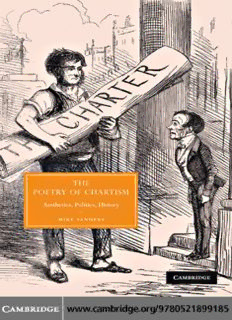
The Poetry of Chartism: Aesthetics, Politics, History PDF
Preview The Poetry of Chartism: Aesthetics, Politics, History
This page intentionally left blank THE POETRY OF CHARTISM Between1838and1852,theleadingChartistnewspaper,theNorthern Star, published over 1,000 poems written by more than 350 poets – as the readership of the Northern Star numbered hundreds of thousands, these poems were amongst the most widely read of the Victorianera.Thisbookisthefirstfull-lengthstudyoftheNorthern Star’s poetry column and offers a complete record of all the poems published.Itasksasimplequestion:whydidthewritingandreading of poetry play such an important role in Chartism’s struggle to secure fundamental democratic rights? It answers this question by analysingtheinterplaybetweenpolitics,aestheticsandhistoryinthe aftermathoftheNewportinsurrection(1839),duringthemassstrikes of 1842 and the year of European revolutions (1848). Additionally, thebooktheorisespoetry’spoliticalagencyandexaminesthecritical history of Chartist poetry. mike sanders is Lecturer in Nineteenth-century Literature and Theory at the University of Manchester. cambridge studies in nineteenth-century literature and culture General Editor Gillian Beer, University of Cambridge Editorial Board Isobel Armstrong, Birkbeck, University of London Kate Flint, Rutgers University Catherine Gallagher, University of California, Berkeley D. A. Miller, University of California, Berkeley J. Hillis Miller, University of California, Irvine Daniel Pick, Birkbeck, University of London Mary Poovey, New York University Sally Shuttleworth, University of Oxford Herbert Tucker, University of Virginia Nineteenth-century British literature and culture have been rich fields for interdisciplinary studies. Since the turn of the twentieth century, scholars and criticshavetrackedtheintersectionsandtensionsbetweenVictorianliteratureand the visual arts, politics, social organisation, economic life, technical innovations, scientific thought – in short, culture in its broadest sense. In recent years, theoreticalchallengesandhistoriographicalshiftshaveunsettledtheassumptionsof previous scholarly synthesis and called into question the terms of older debates. Whereas the tendency in much past literary critical interpretation was to use the metaphor of culture as ‘background’, feminist, Foucauldian, and other analyses have employed more dynamic models that raise questions of power and of circulation. Such developments have re-animated the field. This series aims to accommodate and promote the most interesting work being undertaken on the frontiers of the field of nineteenth-century literary studies: work which intersects fruitfullywithotherfieldsofstudysuchashistory,orliterarytheory,orthehistory of science. Comparative as well as interdisciplinary approaches are welcomed. A complete list of titles published will be found at the end of the book. THE POETRY OF CHARTISM Aesthetics, Politics, History MIKE SANDERS CAMBRIDGE UNIVERSITY PRESS Cambridge, New York, Melbourne, Madrid, Cape Town, Singapore, São Paulo Cambridge University Press The Edinburgh Building, Cambridge CB2 8RU, UK Published in the United States of America by Cambridge University Press, New York www.cambridge.org Information on this title: www.cambridge.org/9780521899185 © Mike Sanders 2009 This publication is in copyright. Subject to statutory exception and to the provision of relevant collective licensing agreements, no reproduction of any part may take place without the written permission of Cambridge University Press. First published in print format 2009 ISBN-13 978-0-511-50845-5 eBook (NetLibrary) ISBN-13 978-0-521-89918-5 hardback Cambridge University Press has no responsibility for the persistence or accuracy of urls for external or third-party internet websites referred to in this publication, and does not guarantee that any content on such websites is, or will remain, accurate or appropriate. In memory of my father Terry Sanders 1943 2008 – Contents Acknowledgements page viii Introduction 1 1 The Chartist imaginary: ‘talking by turns of politics and poetry’ 6 2 Chartist poetry and literary history 38 3 ‘A jackass load of poetry’: the Northern Star’s poetry column 1838–1852 69 4 Insurrectionary sonnets: the ideological afterlife of the Newport uprising 87 5 ‘Merry England’: memory and nostalgia in the year of the mass strike 129 6 ‘The future-hastening storm’: Chartist poetry in 1848 166 7 Constellating Chartist poetry: Gerald Massey, Walter Benjamin and the uses of messianism 203 Appendix A: Three Chartist poems 225 Appendix B: Details of poetry published in the poetry column of the Northern Star 230 Bibliography 286 Index 295 vii Acknowledgements The seeds of this study were sown many years ago when my partner Cathy Cundy discovered a copy of Kovalev’s Anthology of Chartist Literature in a second-hand bookshop in Derbyshire. From this chance discovery, a research project was born. In the course of writing about the intersections of literature and history in the nineteenth century, I have often considered how that same conjunction has operated in my own lifetime. Those meditations have convinced me of my extreme good fortune at having been born at the height of the welfare state (the finest achievement to date of the British Labour movement). The combination of a comprehensive secondary schooling and free higher education gave me opportunities denied to previous generations of my family. The opportunities I have enjoyed are not just the product of educa- tionalstructures–individualeducatorshaveplayedanequallycrucialrole and there are seven teachers in particular to whom I owe an incalculable debt. Mrs Johnson and Miss Cox taught me respectively to value the meaning of words and to relish their beauty. Mrs Harrington and Miss Wright schooled me in the vital connections between literature and the social order. Mr David Blair kept a sometimes obstreperous under- graduate on track, and his precise and subtle reading skills illuminated lecturehallandseminarroomalike.AtBirkbeck,thatmostremarkableof institutions, I was fortunate enough not only to find, in Professor Laura Marcus, a PhD supervisor who exerted a profound influence on my thinking, but also to learn from Professor Isobel Armstrong. Those of us working in the field of Victorian Poetry know the nature of the general intellectual debt we owe to her work. On a personal level her encour- agement and support have been equally inspirational. I have learnt much from friends, colleagues and students at the Uni- versities of Exeter, Aberystwyth, Northampton, Lancaster and most recently Manchester. Particular thanks are owed to Florence Boos, Malcolm Chase, Ian Haywood, Helen Rogers and Roy Vickers, for their viii
Description: